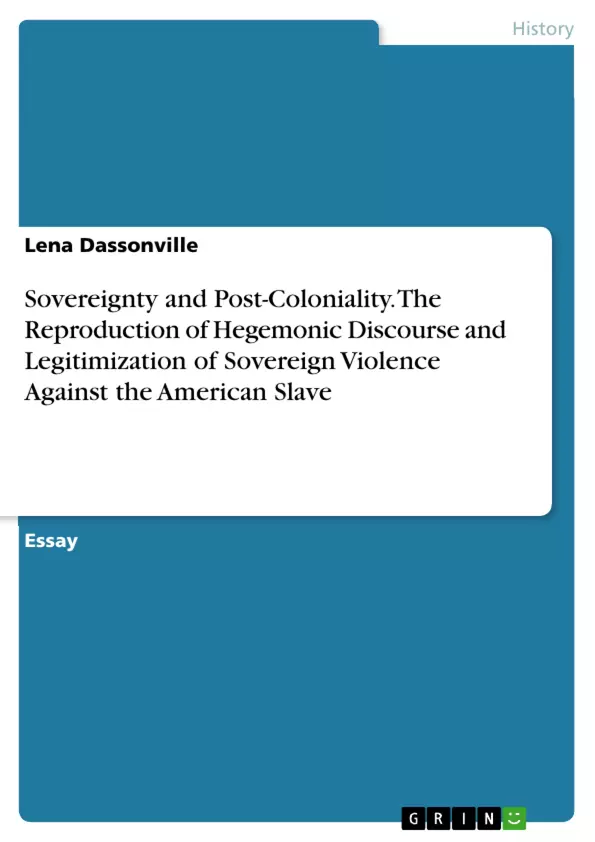I aim to explore the question of American slavery in the mid 19th century by looking through literary, legal, and post-colonial lenses in an effort to show how abolition-era literary narratives utilize stereotype to reproduce a racist discourse and, further, how legal documents and actions reduce the slave to 'homo sacer' through a state of exception, ultimately making the slave the subject of legitimized sovereign violence.
Uncle Tom’s Cabin, published in 1852 by Harriet Beecher Stowe, is an anti-slavery, abolition-era narrative detailing the lives of a black slave family in the south. Though written with good intentions and anti-slavery sentiments, Stowe deploys a hegemonic ideology by confining slaves to their stereotypic bounds—lamenting slavery while utilizing a typical, Africanist-African-American depiction of slaves. Stowe reproduces a racist discourse by constructing stereotypical characterizations of black slaves; specifically their appearance and how they behave in comparison to their white counterparts.
Inhaltsverzeichnis (Table of Contents)
- Sovereignty and Post-Coloniality: The Reproduction of Hegemonic Discourse and Legitimization of Sovereign Violence Against the American Slave
- The Construction of Stereotype and Its Role in Colonial Discourse
- Stereotype as a Fetishization of the "Other"
- The Reproduction of Hegemonic Discourse in Uncle Tom's Cabin
- The Mammy Stereotype and Its Representation in Uncle Tom's Cabin
- The "Othering" of Aunt Chloe
Zielsetzung und Themenschwerpunkte (Objectives and Key Themes)
This work aims to explore the complexities of American slavery in the mid-19th century through literary, legal, and post-colonial lenses. It analyzes how abolition-era narratives, particularly Uncle Tom's Cabin, perpetuate racist discourse through stereotypical representations of slaves. Moreover, it examines how legal documents and actions contribute to the dehumanization of slaves, ultimately legitimizing state violence against them.
- The role of stereotypes in the reproduction of hegemonic discourse
- The impact of colonial discourse on the construction of racial identity
- The use of legal mechanisms to justify violence against slaves
- The representation of slaves in abolition-era literature
- The implications of the "mammy" stereotype for Black female identity
Zusammenfassung der Kapitel (Chapter Summaries)
- The Construction of Stereotype and Its Role in Colonial Discourse: This chapter examines how stereotypes function as a discursive strategy in colonial discourse, emphasizing their role in creating and perpetuating a fixed and unchanging "other." It draws on Homi Bhabha's theory of ambivalence and fixity to understand the paradoxical nature of stereotypes.
- Stereotype as a Fetishization of the "Other": This section explores Bhabha's concept of fetishization in relation to colonial stereotypes. It argues that blackness is simultaneously inscribed as both animalistic and desirable, contributing to a discourse of racial homogenization.
- The Reproduction of Hegemonic Discourse in Uncle Tom's Cabin: This section analyzes Harriet Beecher Stowe's Uncle Tom's Cabin, focusing on how the novel reinforces stereotypical representations of slaves and perpetuates a racist discourse despite its anti-slavery intentions. It highlights Stowe's reliance on the tired stereotype of intrinsic differences between black and white people.
- The Mammy Stereotype and Its Representation in Uncle Tom's Cabin: This chapter examines the "mammy" stereotype and its portrayal in Uncle Tom's Cabin. It analyzes how the character of Aunt Chloe exemplifies this stereotype, particularly through her appearance, behavior, and role as a faithful and obedient slave.
- The "Othering" of Aunt Chloe: This final section investigates how Aunt Chloe is "othered" by white characters in the novel, demonstrating the ways in which stereotypes contribute to the dehumanization and marginalization of slaves. It highlights the use of language and the denial of individual agency to maintain the constructed racial hierarchy.
Schlüsselwörter (Keywords)
This work focuses on the intersection of sovereignty, post-coloniality, and the discourse surrounding American slavery. Key terms include: hegemonic discourse, stereotype, racial difference, colonial discourse, legal violence, homo sacer, state of exception, abolitionism, Uncle Tom's Cabin, mammy stereotype, and the "othering" of slaves.
- Quote paper
- Lena Dassonville (Author), 2016, Sovereignty and Post-Coloniality. The Reproduction of Hegemonic Discourse and Legitimization of Sovereign Violence Against the American Slave, Munich, GRIN Verlag, https://www.grin.com/document/346600



